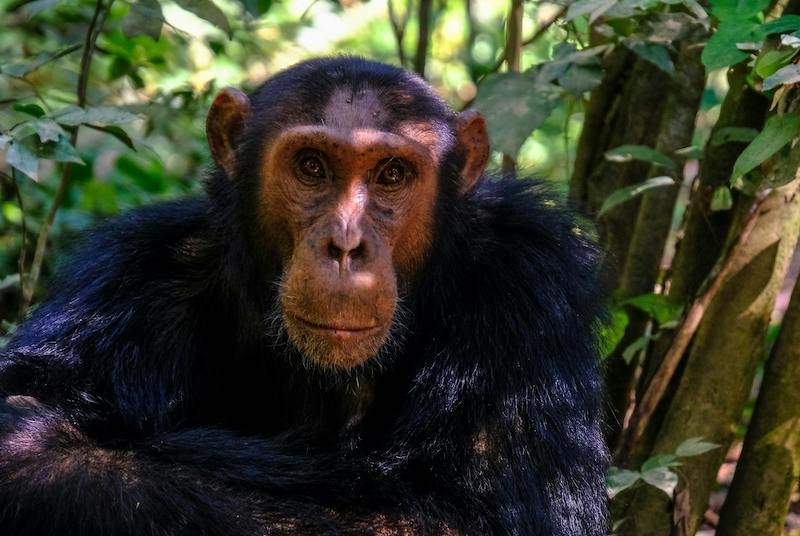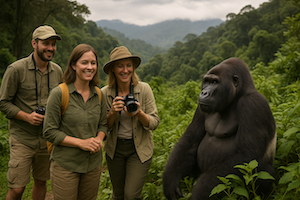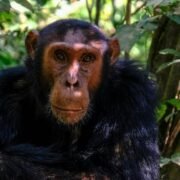
Mountain Gorillas and Chimpanzees in Uganda

Introduction
Uganda is one of the best places in the world to encounter mountain gorillas and chimpanzees in the wild. Therefore, these incredible primates share up to 98% of our DNA and offer unforgettable safari experiences. Whether you’re trekking in misty mountains or navigating lush lowland forests, Uganda gives you a rare opportunity to observe their behavior, social structure, and survival skills. In this article, we’ll explore their species, breeding, gestation, populations, physical traits, where to find them, and how to see them ethically.
Mountain Gorilla and Chimpanzee Species in Uganda
Uganda is home to:
- While mountain gorillas are a subspecies found in southwestern Uganda, chimpanzees, on the other hand, are more widespread..
- Eastern chimpanzees (Pan troglodytes schweinfurthii), a subspecies of the common chimpanzee.
Therefore, there are no lowland gorillas or bonobos in Uganda—only the above two types. Mountain gorillas are found only in Uganda, Rwanda, and the DRC, making Uganda’s conservation efforts even more critical.
Breeding and Gestation of Mountain Gorillas and Chimpanzees
Mountain gorillas and chimpanzees do not have fixed breeding seasons, although mating often increases during the wet season due to abundant food.
- Gorilla Gestation: About 8.5 months
- Chimpanzee Gestation: About 7.5 to 8 months
In both species, females typically give birth to one infant every 4–6 years for gorillas and every 3–5 years for chimpanzees. Therefore, their slow reproduction rates make conservation essential.making conservation vital.
Population of Mountain Gorillas and Chimpanzees in Uganda
Uganda has made significant strides in primate conservation:
- Mountain Gorillas: Over 460 individuals live in Bwindi Impenetrable National Park, making it home to more than half of the world’s population.
- Chimpanzees: Approximately 5,000–6,000 chimpanzees roam Uganda, with the largest groups in Kibale Forest National Park.
These numbers reflect ongoing conservation efforts; however, both species remain vulnerable due to habitat loss, poaching, and disease.These numbers reflect ongoing conservation efforts; however, both species remain vulnerable due to habitat loss, poaching, and disease.da’s vital role in global primate conservation.
Physical Characteristics and Behavior
- Height: 4.5 to 6 feet when standing
- Weight: 220–430 lbs (males heavier)
- Hair: Long, dark fur suitable for cool mountain climates
- Behavior: Peaceful, live in family groups led by a dominant silverback
Chimpanzees
- Height: 3.3 to 5.6 feet (standing upright)
- Weight: 70–130 lbs
- Hair: Black or dark brown, thinner than gorilla fur
- Behavior: Highly social, use tools, live in troops of up to 100 individuals
Both primates share 98–99% of their DNA with humans, making observing them a truly emotional and fascinating experience.
Where to See Mountain Gorillas and Chimpanzees in Uganda
Mountain Gorillas:
- Bwindi Impenetrable National Park
–Four gorilla trekking regions: Buhoma, Ruhija, Rushaga, Nkuringo
– Home to multiple habituated families
– UNESCO World Heritage Site - Mgahinga Gorilla National Park
– Smaller population but more scenic
– Only one habituated group (Nyakagezi)
Chimpanzees:
- Kibale National Park
– Uganda’s best chimpanzee tracking destination
– Over 1,500 individuals
– Full- and half-day tracking options available - Budongo Forest (Murchison Falls NP)
– Excellent for research-based chimpanzee walks
– Found in the Kaniyo Pabidi sector - Kalinzu Forest Reserve
– Near Queen Elizabeth National Park
– Affordable and scenic chimp tracking location - Kyambura Gorge (Queen Elizabeth NP)
– Known as the “Valley of Apes”
– Offers a chance to track a smaller chimp population in a dramatic landscape.
How to See Them – Permits and Trekking Tips
To visit mountain gorillas and chimpanzees, you need permits issued by the Uganda Wildlife Authority:
- Gorilla Trekking Permit: $800 (foreign non-residents)
- Chimpanzee Trekking Permit: $250 (Kibale), $50–85 (Kyambura/Budongo)
Trekking Tips:
- Book permits early, especially in peak seasons (June–August, Dec–Feb)
- Wear sturdy hiking boots and long-sleeved clothes
- Carry insect repellent and at least 2 liters of water
- Stay 6–10 meters away from the primates
Note: Only 8 visitors are allowed per gorilla group per day to reduce stress and exposure to human disease.
Why Uganda is the Best Place for Primates
Uganda is the only country where you can see both mountain gorillas and chimpanzees in their natural habitats on a single safari. Additionally, the country offers:
- Affordable permits compared to Rwanda
- Rich biodiversity and scenic beauty
- Friendly, knowledgeable guides and rangers
Moreover, Uganda’s ecotourism model ensures your visit benefits local communities and conservation.
Conservation Efforts and Responsible Travel
Mountain gorillas were once critically endangered. Thanks to conservation efforts by UWA, WWF, and the Dian Fossey Gorilla Fund, their numbers are steadily rising.
Travelers can support this by:
- Choosing ethical tour operators
- Avoiding contact and maintaining a 7-meter distance
- Never trekking when sick
- Supporting community-based tourism programs
Learn more about conservation at https://www.worldwildlife.org/species/mountain-gorilla
Conclusion
Mountain gorillas and chimpanzees in Uganda are more than just wildlife—they are powerful symbols of conservation, resilience, and the deep connections we share with nature. With careful planning and respect for the environment, you can witness these incredible primates in their natural home. Whether you’re trekking through misty Bwindi or the lush jungles of Kibale, Uganda offers a primate safari like no other.
Recent Posts
Hartebeest vs Topi in Uganda: Species, Parks & Key Differences
Mountain Gorillas and Chimpanzees in Uganda
Monkeys in Uganda: Species, Parks & Safari Guide
Tags

Thailand




